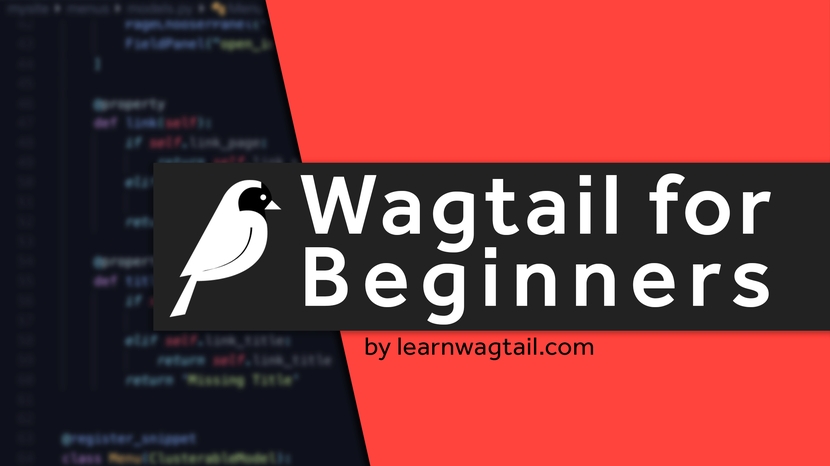Tutorial Wagtail Version: 2.x
Installing Wagtail using Venv
This is a clip from the Wagtail for Beginners course. Learn how to setup a brand new Wagtail project using pure Python. No Docker, no virtualenv, no Pipenv, nothing fancy. We'll use Pythons built in venv command.
Sometimes the best way to get started is the easiest. When you're just getting started with a Python project, it can take time to setup Docker, or a specialized virtual environment.
In this tutorial we'll create a brand new virtual environment using Pythons venv command.
It's so easy, it can be done in one simple command.
Creating a new virtual environment with venv
This command is about 100x easier than using Docker. And in my opinion it's just as easy as setting up a project with Pipenv or virtualenv. To create a new venv simply type this command in your project directory:
python -m venv .venv/
Activating your venv
Activating your venv is the same as using virtualenv, if you've ever used that. It's as easy as:
source .venv/bin/activate
Getting out of your venv
Once you're inside of your venv you cant type deactivate to get out of it.
Deleting your venv
Sometimes we break something or make a mistake (like typos!) and we want to start over. All we need to do is delete the .venv/ directory. You can either open the project folder and delete the .venv/ folder, or cd to your project form your favourite command line program and type rm -rf .venv/ (but please be careful when using rm!)
—
This lesson is a clip from the Wagtail for Beginners course where you'll learn how to create a brand new Wagtail website from scratch. It includes pretty much all the code you'll use on every single Wagtail website including a custom menu, Orderables, and even caching mechanisms. (and feel free to steal the source code!). You'll also learn how to setup your Wagtail website on a production server using Ubuntu.

Related tutorials
Installing Django Debug Toolbar
Posted on
Learn how to add one of the most useful Django debugging tools into your new Wagtail project. We'll go through the installation docs, learn how base.py, dev.py and production.py work together, and how to install Django Debug Toolbar.
View lesson, Installing Django Debug Toolbar
Registering Snippets using Django Models
Posted on
Snippets are Wagtails way of re-using existing data. For example, being able to select a Blog Author (or multiple authors) instead of having to add a name, image and website for every blog author in every blog post you make; instead you can simply fill out a form once, and re-use the final data with a couple of clicks.
View lesson, Registering Snippets using Django Models
Registering Snippets (Blog Category) using Checkboxes
Posted on
In this tutorial we'll be learning how to register another Wagtail Snippet, but instead of using an Orderable and a SnippetChooserPanel (like the previous lesson) we're going to use a ParentalManyToManyField and a form widget to create Checkboxes in the Wagtail Admin.
View lesson, Registering Snippets (Blog Category) using Checkboxes
How to Install Wagtail Using Pipenv (in less than 6 minutes)
Posted on
Lots of Python developers use Pipenv to setup projects and separate their dependencies from their local machine. In this video we'll install Wagtail from scratch. (Step by step instructions are inside
View lesson, How to Install Wagtail Using Pipenv (in less than 6 minutes)
Installing Django Debug Toolbar
Posted on
Learn how to add one of the most useful Django debugging tools into your new Wagtail project. We'll go through the installation docs, learn how base.py, dev.py and production.py work together, and how to install Django Debug Toolbar.
Registering Snippets using Django Models
Posted on
Snippets are Wagtails way of re-using existing data. For example, being able to select a Blog Author (or multiple authors) instead of having to add a name, image and website for every blog author in every blog post you make; instead you can simply fill out a form once, and re-use the final data with a couple of clicks.
Registering Snippets (Blog Category) using Checkboxes
Posted on
In this tutorial we'll be learning how to register another Wagtail Snippet, but instead of using an Orderable and a SnippetChooserPanel (like the previous lesson) we're going to use a ParentalManyToManyField and a form widget to create Checkboxes in the Wagtail Admin.
How to Install Wagtail Using Pipenv (in less than 6 minutes)
Posted on
Lots of Python developers use Pipenv to setup projects and separate their dependencies from their local machine. In this video we'll install Wagtail from scratch. (Step by step instructions are inside
